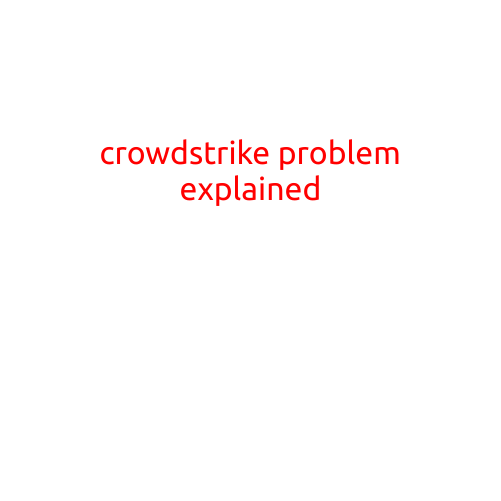
CrowdStrike Problem Explained: Unpacking the Controversy Surrounding the 2020 Election
In the aftermath of the 2020 United States presidential election, a growing controversy has emerged surrounding the use of Crowdstrike, a cybersecurity firm hired by the Democratic National Committee (DNC) to investigate a hack of their email servers. The company’s conclusions have been disputed by the Trump administration, leading to a heated debate about the firm’s methods and findings. In this article, we will delve into the CrowdStrike problem and provide an explanation of the controversy.
The Backstory
In May 2016, the DNC announced that it had suffered a data breach, resulting in the theft of sensitive information, including sensitive emails and donor data. The FBI was immediately notified, and an investigation was launched. The DNC hired Crowdstrike, a privately-held cybersecurity firm, to conduct an independent investigation into the hack.
Crowdstrike’s report concluded that the hack was the work of Russian state-sponsored hackers, known as Advanced Persistent Threat (APT) 28 and APT 29, which are believed to be part of the Russian intelligence agencies. This conclusion was supported by the Intelligence Community Assessment (ICA) published in January 2017, which also attributed the hack to Russian interference in the election.
The Dispute
However, in May 2020, President Donald Trump and his allies began questioning Crowdstrike’s findings, citing what they claimed were inconsistencies in the company’s methodology and conclusions. Trump himself has repeatedly referred to Crowdstrike as “a total disaster” and “a complete scam.”
The main points of contention include:
- Inconsistencies in the timestamp of the hack: Trump and his supporters point to discrepancies in the timestamp of when the hack allegedly occurred, suggesting that the hack may not have taken place at all. Crowdstrike has responded by stating that the timestamp inconsistencies are due to the nature of the hacking process and that the investigation’s findings remain unchanged.
- Lack of concrete evidence: Trump’s supporters argue that there is no concrete evidence linking Russia to the hack, and that the conclusions drawn by Crowdstrike and the Intelligence Community are based on circumstantial evidence and assumptions. Crowdstrike has countered by stating that their methodology is based on decades of experience and specialized expertise in cybersecurity and that their findings are backed by multiple lines of evidence.
- Conflict of interest: Some have raised concerns about a potential conflict of interest in Crowdstrike’s role in both the investigation and the response to the hack. Crowdstrike’s CEO, George Kurtz, has previously stated that his company will not take any actions that could potentially influence the investigation.
Conclusion
The CrowdStrike problem has become a contentious issue in American politics, with each side presenting its own perspective on the hack and the investigation. While Crowdstrike’s conclusions remain unchanged, the controversy surrounding the firm’s methodology and findings has raised important questions about the credibility of cybersecurity firms and the role of the Intelligence Community in election security.
As the United States continues to grapple with the complexities of cybersecurity and election interference, it is essential to maintain a nuanced understanding of the issues at play. By unpacking the CrowdStrike problem and examining the underlying tensions, we can work towards a more informed and fact-based discourse about the importance of cybersecurity in our democratic processes.





